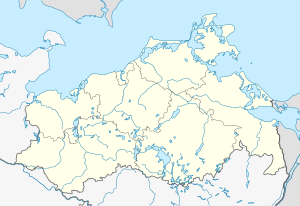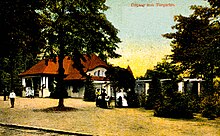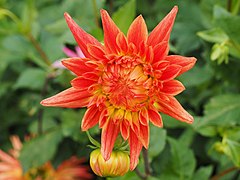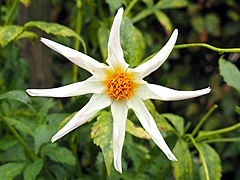Rostock Zoo
| Rostock Zoo | ||
|---|---|---|
| Full name | Rostock Zoological Garden | |
| motto | A whole year of adventure | |
| place | Barnstorfer Ring 1 18059 Rostock |
|
| surface | 56 hectares | |
| opening | January 4, 1899 | |
| Animal species | 430 | |
| Individuals | 4,200 | |
| Visitor numbers | 632,337 (2014) | |
| organization | ||
| management | Udo Nagel managing director | |
| Sponsorship | Rostock Zoological Garden gGmbH | |
| Funding organizations | Rostocker Zooverein eV | |
| Member of | WAZA , EAZA , VdZ , State Zoo Association MV | |
|
Overview map of Rostock Zoo |
||
| www.zoo-rostock.de | ||
|
|
||
Coordinates: 54 ° 4 ′ 41.1 ″ N , 12 ° 5 ′ 25.3 ″ E
The Rostock Zoological Garden in the Hanseatic City of Rostock was founded in 1899. It extends over an area of 56 hectares in the Barnstorfer Forest . With around 4200 animals of 430 different species, it is the largest zoo on the German Baltic coast. The Rostock Zoo is one of the most popular excursion destinations in northern Germany, and has been awarded the “family-friendly facility” seal of approval by the regional tourism association several times. In 2015 it was named Europe's best zoo in its category (up to one million visitors) by zoo analyst Anthony Sheridan. There were particularly good marks for the quality of the animal houses and enclosures, for its green landscape and vegetation, the unique zoological-botanical ambience and for the diverse educational offers.
Historical development
From the foundation to 1945
During the German-Danish War around 1864, the former parade ground in the Barnstorfer Tannen was redesigned. A park-like area with trees was created. In 1866 the complex around the Trotzenburg hunter's apartment was completed. The tree population was further supplemented by a wide variety of species in the years to come. In 1883, for example, a sequoia tree was planted on the complex's duck pond . In 1898 other animal species moved into the game reserve. Wild boars , a pair of roe deer and deer were included in the enclosure. The supervising forester Schramm set up a small zoo in the same year. The Hirschgarten on the Trotzenburg opened on January 4, 1899 . Carl Lange was hired as the first animal keeper. The Deer Park was in the same year by other species growth. So were Angora cats , eagles , deer , jackals , raccoons and foxes included in the animal population. In 1904 the horse-drawn tram stop in front of the Trotzenburg entrance was replaced by an electric tram stop . A mast of the overhead line can still be seen at the stop today. Forester Schramm endeavored in the following years to further expand the site and enlarge the facility. In 1906, after Förster Schramm contacted the hospital administration - the owner of the Barnstorfer Tannen at the time - the city of Rostock commissioned the establishment of a game and dendrological garden . The construction of the garden, which was opened in 1910 at Pentecost, was headed by City Planning Director Tessendorf and Horticultural Director Schomburg. Colloquially, however, the Rostockers remembered the term zoo . In 1931 a large dahlia show took place during the main flowering period .
From 1945 to 1989
As a result of heavy air raids on Rostock in the course of the Second World War , the buildings on the zoo grounds and all the facilities were almost completely destroyed. The zoo was rebuilt in 1951 under the direction of the horticultural architect Arno Lehmann. Many Rostockers helped voluntarily and thus supported the reconstruction. The zoo was reopened on September 7, 1952 and expanded from 9 hectares to 16 hectares in 1956. The Rostock Zoological Garden was founded on January 16, 1956. In 1960 the first two Indian elephants moved into the new elephant enclosure. In the early 1960s the Rostock Zoo took over the Institute for Animal Breeding Research Dummerstorf drawn Arabian thoroughbreds and incorporated it as zooeigenes stud at the zoo on. This resulted in the largest Arabian breed in the GDR . In 1963 the first polar bear cub was born in the zoo. It was a female and was named Katja . In 1973 a basic planning for the zoo took place. The zoo should be expanded to 56 hectares. An adventure area was also planned for visitors. An international stud book for polar bears has been kept in the zoo since 1980 . In 1989, a 2000 m² walk-in sea bird aviary for shorebirds was set up in the newly developed part of the zoo . Over 100 birds live in it. A wall made of boulders up to four meters high serves as a breeding ground for the birds.
Since 1989
In 1992 the Gemeinnützige GmbH Zoologischer Garten Rostock was founded under the direction of Udo Nagel as head of the zoo. From 1991 to 1996 many enclosures were redesigned in a species-appropriate manner. Among other things, there was a redesign of equipment for African wild dogs and fur seals . In 1997 a new facility for the hussar monkeys was set up in the extension part of the zoo and in 1998 the stilt bird facility was reconstructed. At the same time, a large suspension bridge was built across the pond. On October 17, 1998, the South America House was inaugurated with an outdoor enclosure. It is home to capuchin and common marmosets . In 1999 the zoo celebrated 100 years of animal gardening . The first Classical Night took place in 1999 and has been repeated annually since then. In the same year Rostock Zoo became a member of the World Zoo Association (WAZA) and the European Zoo Association (EAZA). Zoo director Udo Nagel has also been accepted into the International Association of Zoo Directors. In 2000 the big cat facility was redesigned. It is inhabited by lions , jaguars and snow leopards .
In August 2002, the renovation of the otter facility, which was supported by the income from the gravel donation campaign for the otters , was completed. In the same year the Darwinbox was opened. 2004 was the birth of two cheetah cubs. In October 2004, a 1200 m² petting zoo was inaugurated in which West African dwarf goats live. The elephant house was rebuilt by October 2005. In March 2007, shooting began for the ZDF documentary soap Ostsee-Schnauzen at Rostock Zoo . The shooting lasted four months and a total of 20 episodes were created that report on the life of the animals and the work of the zookeepers. In the same year, the zoo posted a record number of visitors with 555,774 guests. In May 2008 the Café Elefanten-Lodge burned for unknown reasons . In 2009, at the age of 48, the female gorilla Sanga , who had come to the zoo as a tomboy in 1964 , died. In 2010 a young bison left the Rostock Zoo to support a species protection project and to prepare for reintroduction. Cheetah quadruplets were born on July 23, 2010 and had to be raised by hand after their mother died.
In October 2010 the new historical ungulate facility was opened in the heart of the Rostock Zoo. The opening of the Darwineum as a great ape complex with an evolution exhibition took place in September 2012. The zoo was chosen among the 50 best excursion destinations in Germany and is ranked 4th among medium-sized zoos in Europe (2nd place in Germany). The first ape offspring in Darwineum was born in 2013, the orangutan girl Surya. In 2013, the female elephant Sara, then the oldest African elephant in a European zoo, had to be euthanized at the age of 51 due to illness. With it the traditional elephant keeping in the Rostock Zoo was ended for the time being. The successor to the facility has been pygmy hippos since summer 2015 .
In January 2015, 60 birds were emergency killed because 43 of them were found to be infected with the highly contagious variant H5N8 of the bird flu virus. Due to the incident, the site was closed for several days until the samples from all birds were evaluated. In January the zoo was opened partially and a few days later completely.
Darwineum
Named after the founder of evolutionary theory Charles Darwin , Darwineum opened on September 8, 2012. The complex, designed as a living museum, houses more than 80 animal species on an area of 20,000 m² (including western lowland gorilla , Bornean orangutan , ring -tailed lemur , pygmy marmoset , beaked hedgehog , mudskipper and axolotl ) and offers environmental education and science to touch and participate in in interactive exhibition areas . With a cost of 28.94 million euros, it was the largest construction project in the history of the Rostock Zoo. Of this, 22.94 million euros came from funding from the Ministry of Economics, Building and Tourism of the State of Mecklenburg-Western Pomerania , 4.4 million euros from loans, 1.45 million euros from donations and 150,000 euros from funds from the city of Rostock.
In two interactive exhibition areas in the Darwineum, the biological diversity of life in the course of evolution can be experienced, starting with the creation of the universe. Themed boxes with living fossils, aquariums with corals and seahorses and a jellyfish top complete the exhibition. The center of the Darwineum is the tropical hall. The 4,000 square meter tropical house houses the gorillas and orangutans. The great apes live here together with Brazza monkeys and gibbons in natural habitats.
Another exhibition is dedicated to the cultural evolution of humans.
Polarium
On September 22nd, 2018, after a construction period of around two years, the Polarium was opened to visitors. The construction costs amounted to 14.21 million euros, of which the state of Mecklenburg-Western Pomerania contributed around 12 million euros. 350,000 euros were collected in a donation campaign. The outdated bear castle was almost completely demolished and the new Polarium was built on this site in the historical part of the zoo. It is the home of polar bears and penguins. With around 12,500 m², the total area includes a new outdoor enclosure with breeding caves on a slope and a water basin with viewing panels for up to 36 Humboldt penguins and their offspring. On the other hand, there is an extensive, divisible tundra landscape for three adult polar bears and their offspring, which is based on Hudson Bay in terms of design. The Polarium is supplemented with a visitor center, which provides information on the anatomy, development and lifestyle of polar bears, as well as insights into the polar bears' water basins. A "marine world" is shown, in which different types of jellyfish can be seen in different sized jellyfish circles , moray eels and various other aquarium fish. Thematically, the polar regions are placed in the foreground. The penguins are all about adapting to different habitats.
Others
In the Rostock Zoo, natural-looking facilities are combined with a park landscape with old trees and shrubs. Zoology and botany, such as the historic rhododendron groves, the dahlia quarter and the oak avenue, are spread over 56 hectares.
Attractions include experience stations, a water themed trail and a climbing forest for children.
There is public feedings for fur seals, penguins, lions and trample. It is also possible to work as a “temporary animal keeper” for penguins, zebras or seals. Thematic tours are offered.
The Rostock Zoological Garden is a member of the World Zoo Association (WAZA) and is globally involved in breeding and reintroduction projects. Because of the success in rearing polar bears, the international stud book has been kept here since 1980.
Dahlia roost
In 1931 Wilhelm Schomburg, Rostock's first city gardening director, planned a dahlia show in what was then the zoo. 36 dahlia growers from all over the country took part. This garden area has been preserved to this day. Every year dahlias are planted here in the Rostock zoo . The area at the South America House was placed under monument protection in 1986 . In 1988 the "Dahlia Quarter" was reconstructed according to Schomburg's historical plans.
- Dahlia show at Rostock Zoo
See also
Individual evidence
- ↑ a b Animals & Park. on zoo-rostock.de
- ↑ Media information. Rostock Zoo, January 28, 2015.
- ↑ Our animals in the Rostock Zoo. (zoo-rostock.de)
- ↑ Excursion destinations in Mecklenburg-Western Pomerania. In: https://www.zoo-rostock.de/ . Rostock Zoological Garden gGmbH, accessed on December 11, 2019 .
- ↑ Best zoo in Europe. (zoo-rostock.de)
- ^ History of the Rostock Zoo , accessed on August 10, 2012.
- ↑ Fire in the Rostock Zoo causes property damage. In: Ostseezeitung. May 15, 2008, p. 6.
- ↑ 43 Evidence of bird flu in Rostock's zoo. In: Nordkurier. January 12, 2015.
- ↑ Polarium opened at Rostock Zoo. September 21, 2018 (rostock-heute.de accessed October 2, 2018)
- ↑ Park & Art in Rostock Zoo. (zoo-rostock.de)
- ↑ Experience stations. (zoo-rostock.de)
- ↑ Dahlia Gardens. (dahlie.net)














